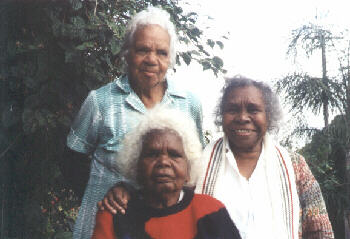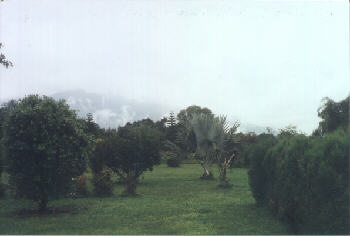Ngadjonji Elders Stories

Note: this site contains images of aboriginal people now deceased
Revisiting the Bora Ground
Massacre
Revisiting the Bora Ground
byGrace Kidner, Emma Johnston, Jessie Callico, Henry robinson and George Davis as told to M.Huxley
In August 1999, Ngadjonji elder, Mrs Grace Kidner, returned to Malanda to visit her childhood friends Emma Johnston and Miss Jessie Calico and her brother Henry Robinson. Grace married Jirrbal man Jerry Kidner in Atherton and when he was sent to Palm Island just after the war she accompanied him. Grace Kidner has lived on Palm Island, where for many years she was the chief cook, for over fifty years and brought up six children there. To her great sadness, her mother, brother and sister were all sent to Woorabinda in 1946, and all died there.
Emma Johnston, who is now 82, remembers Gracie as a small child who was always following her around.

Ngadjonji Elders, Emma Johnston, Grace Kidner and
Jessie Callico during Grace's visit. During Grace’s visit,
Auntie Emma organised a visit to the old Bora Grounds at Butchers Creek. Grace was born at top camp, which is near the Bora Ground. Just behind Lamins Hill on a small plateau that enjoys a brilliant view through the passage between Jurra Julam (Mt Bartle Frere) and Lamins Hill straight through to the sea, the Bora Ground, called Bulaba in Ngadjon, was used for corroboree (warrama) and intitiation.
Bulaba is now a private property but Emma remembers the time in her childhood when the Malinbarra Yidinyji and the Ngadjonji used it as an Initiation ground. She remembers the time when it was the great meeting place for warrima when Mamu, Jirrbal and Malinbarra Yidinyji would all be invited by their Ngadjonji hosts. The people would all camp in the bush until the day of ceremony and then the men would noisily enter the grounds in full warrama dress, with mock ferocity chanting and displaying their implements. They would run around the huge circle chanting and dancing and Emma says that as a small child she would ‘cut for it’ back to camp, completely terrified. The warrama would go on for three days and nights, with ritual fighting, dancing, chanting. Combat was to settle disputes and at the end of the warrama all was forgiven; that was the end of the matter.
Elder George Davis, of the Malinbarra Yidinyji, says that Bulaba was used for initiation because so many wise old men lived there.

Bulaba, the old Bora Ground near Butchers Ck.
Jurra Julam (Mt Bartle Frere) looms through the mist
They helped the initiate maintain the dietary rules, initiates could eat no other flesh than eel, and would rub the initiates scars with the sandpaper fig leaf until they were raw then the initiate would jump in the creek next to Bullaba for cleaning. Young men could not marry or take on tribal responsibility until initiation and George says if they were ratbags the old men cut deeper.
When they were young girls Auntie Emma and Auntie Gracie lived out at the top camp at Butchers Creek and went to school there. They remember they would take half a day to walk in to the camp at Malanda and they would stay and visit there for a while. Auntie Gracie is in her seventies now but she remembers her childhood in this country and loves to come back here. The old people dream about one day returning to their own country.
Emma Johnston says the Bora Ground was called Bulaba and the place was called Bulgina. She says her brother Harry Raymont was not initiated and she thinks the last Ngadjonji person to be initiated at Bulaba was her uncle Pompey.
Text & photos - M.Huxley
Massacre
byEmma Johnston as told to M.Huxley
In the year 1880 or thereabouts there was a big massacre around Butchers Creek area. It started at Jillan which is an old Bora ground. The camp population was about five hundred yarra more or less: young and old, men and women.
On a day when the yarra, the men, went hunting, the gumaring, whitemen, visited the camp in their absence and took advantage of their yipi, their women. When the yarra came home they came found the gumaring in the camp with their yipi. So, that's when the war started between them, the Blackman and the Whiteman.
The yarra started fighting with spears.
When the gumaring saw they were being killed one escaped and went back to town to send for police to come out with guns. Most of our people were shot, even the young kids were shot down. Lots of the women ran into the forest to hide and managed to get away and were safe. My Grandmother told me that one of my Aunties was hung up on a lawyer vine but wasn't shot, they missed her. My Grandmother hid in the bladey grass. When the fighting was over she came out of hiding and went back to camp.
Grandmother lived peacefullly for a long time and reared her children. Then she decided to look for a partner. She found a partner and married him and had two yarra, sons, and two yipi, girls, to him. One yipi was shot by the police, the other one disappeared, running away. I don't know where she got to but she was safe. This was common in those days.
Now we are living in a peaceful world for a while.

Ngadjonji Elder, Emma Johnston, is the daughter of Molly Raymont
The shield design, is from a shield of the Butchers Ck Clan of the Ngadjonji recreated in early 2000 by George Davis, Yidinyji Elder and Uncle to the Ngadjonji.

See Shield-Making This massacre is referred to in the Recent History section of the Ngadjonji history anthology in these pages.

